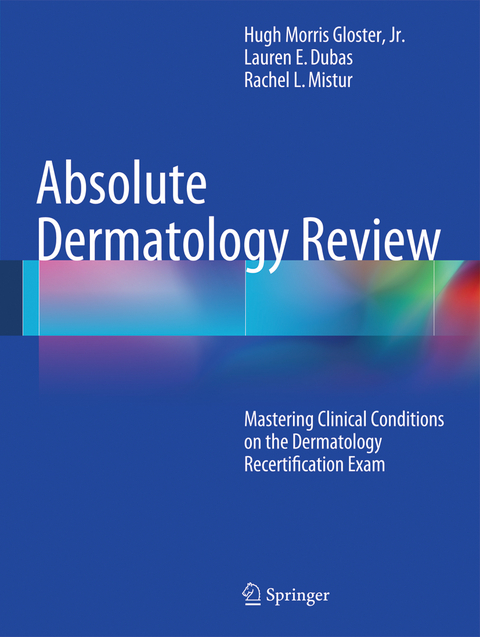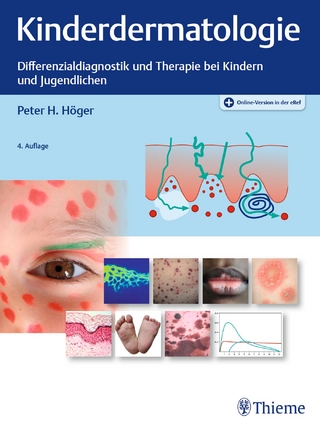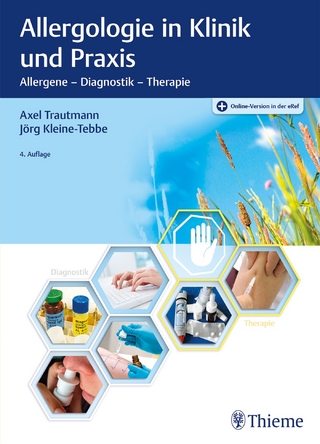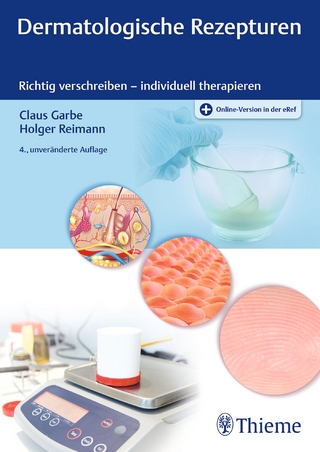
Absolute Dermatology Review
Springer International Publishing (Verlag)
978-3-319-03217-7 (ISBN)
Each dermatologist that was board certified after 1992 is required by the American Board of Dermatology to take a recertification exam every ten years. One of the major components of the exam is to be able to identify clinical photographs of approximately 200 skin diseases, and while there are other components to the test, they vary according to subspecialty. However, everyone is required to identify the images, so several months before the exam, the American Board of Dermatology releases a list of the skin diseases that will be tested, but does not provide the images or reveal which ones will appear.
Review of Clinical Conditions for the Dermatology Recertification Examination provides a thorough, concise review of clinical images of the specific conditions that the reader will be required to recognize during the American Board of Dermatology recertification test. In addition,concise key clinical features for each image will be provided that will assist the reader in recognizing the clinical images on the examination, enabling them a more efficient way to study for the test without having to look up images online or in a large text book. Written by a board certified dermatologic surgeon who recently took the recertification exam, this book proves indispensable to dermatologists taking the exam or residents who want a quick reference of the clinical appearances of the main conditions generally encountered by a dermatologist.
Dr. Hugh Gloster is Professor of Dermatology and Director of Mohs Micrographic Surgery & Cutaneous Oncology at the University of Cincinnati Department of Dermatology.
Section One: Papulosquamous and Eczematous Dermatoses;1. Psoriasis;2. Lichen planus;3. Dermatitis;4. Keratosis pilaris;5. Lichen simplex chronicus;6. Lichen striatus;7. Pityriasis lichenoides;8. Pityriasis rosea;9. Pityriasis alba;10. Pityriasis rubra pilaris;11. Axillary granular parakeratosis;Section Two: Cutaneous vasculitis, vasculopathy, and microvascular occlusion syndromes;12. Small vessel (leukocytoclastic) vasculitis;13. Mixed small and medium vessel vasculitis;14. Medium size vasculitis;15. Livedo vasculopathy and livedo reticularis;16. Coumadin necrosis;Section Three: Vesiculobullous diseases;17. Bullous pemphigoid;18. Cicatricial pemphigoid;19. Pemphigoid gestationis;20. Pemphigus vulgaris;21. Pemphigus foliaceous;22. Pemphigus vegetans;23. Benign familial pemphigus (Hailey-Hailey disease);24. Dermatitis herpetiformis;25. Linear IgA bullous dermatosis;26. Epidermolysis bullosa;27. Newborn;28. Paraneoplastic pemphigus;Section Four: Adnexal diseases;29. Acne vulgaris;30. Rosacea;31. Fox Fordyce disease;32. Hidradenitis suppurativa;Section Five: Autoimmune disorders;33. Lupus erythematous;34. Dermatomyositis;35. Scleroderma and sclerodermoid skin conditions;36. Graft versus host disease;Section Six: Metabolic and depositiondiseases;37. Mucinoses;38. Amyloidosis;39. Porphyria cutanea tarda and pseudoporphyrias;40. Calcifying disorders;41. Nutritional diseases;42. Ochronosis;Section Seven: Cutaneous manifestations of systemic diseases;43. Rheumatoid arthritis;44. Diabetes;45. Thyroid disease;46. Cushing's syndrome;47. Addison's disease;48. Gastrointestinal;49. Renal disease;50. Internal malignancy;Section Eight: Genodermatoses and developmental anomalies;51. Genodermatoses;52. Developmental anomalies;Section Nine: Infections;53. Viral;54. Fungal;55. Bacterial;Section Ten: Infestations and bites;56. Cutaneous larva migrans;57. Bed bugs;58. Spider bites;59. Scabies;60. Fleas;61. Pediculosis (lice);62. Tungiasis;Section Eleven: Hair, nails, and mucous membranes;63. Alopecias64. Nail disease;;65. Mucous membrane disease;Section Twelve: Benign neoplasms;66. Accessory tragus;67. Accessory digit;68. Acquired digital fibrokeratoma;69. Adnexal tumors;70. Becker's nevus;71. Cysts;72. Dermatofibroma;73. Melanocytic;74. Mucocele;75. Pyogenic granuloma;76. Seborrheic keratosis;77. Skin tags;78. Supernumerary nipples;79. Confluent and reticulated papillomatosis;80. Linear epidermal nevus;Section Thirteen: Malignant and premalignant neoplasms;81. Actinic keratosis;82. Actinic cheilitis;83. Angiosarcoma;84. Cutaneous metastases;85. Dermatofibrosarcomaprotuberans;86. Kaposi's sarcoma;87. Keratoacanthoma;88. Melanoma ;89. Basal cell carcinoma;90. Squamous cell carcinoma91. Paget's disease;92. Extramammary Paget's disease;93. Cutaneous lymphomas;Section Fourteen: Disorders due to physical agents;94. Chondrodermatitis nodularis helicis;95. Factitial disease;96. Prurigo nodularis;97. Trauma induced skin disease;98. Photodermatoses;99. Foreign body granulomas;100. Radiation dermatitis;Section Fifteen: Drug reactions, erythemas, and urticarias;101. Drug reactions;102. Erythemas;103. Urticarias;104. Polymorphic eruption of pregnancy (PUPPP);Section Sixteen: Vascular and lymphatic disorders;105. Telangiectasia;106. Hemangioma;107. Vascular malformations;108. lymphangiomas;Section Seventeen: Pigmentary disorders;109. Vitiligo;110. Postinflammatory pigment alteration;Section Eighteen: Neutrophilic dermatoses;111. Pyoderma gangrenosum;112. Sweet's syndrome;113. Erosive pustular dermatosis of the scalp;Section Nineteen: Disorders of Langerhans cells, macrophages, and mast cells;114. Langerhans cell histiocytosis;115. Xanthogranuloma;116. Xanthomas;117. Sarcoidosis;118. Granuloma annulare;119. Necrobiosis lipoidica ;120. Foreign body reactions ;121. Mastocytosis;Section Twenty: Dermal connective tissuedisorders;122. Keloids;123. Hypertrophic scars;124. Perforating diseases;Section Twenty One: Panniculitis;125. Erythema nodosum;126. Lipodermatosclerosis (sclerosing panniculitis)
"If you are facing the chore of taking the recertifying/certifying exam for dermatology, this study guide will help prepare you. The purpose is to help readers study and be well prepared to pass the certification exam in dermatology. This is a useful study aid for preparing for the exam." (Patricia Wong, Doody's Book Reviews, August, 2015)
"If you are facing the chore of taking the recertifying/certifying exam for dermatology, this study guide will help prepare you. The purpose is to help readers study and be well prepared to pass the certification exam in dermatology. This is a useful study aid for preparing for the exam." (Patricia Wong, Doody's Book Reviews, August, 2015)
| Erscheint lt. Verlag | 11.6.2015 |
|---|---|
| Zusatzinfo | XVII, 534 p. 769 illus. in color. |
| Verlagsort | Cham |
| Sprache | englisch |
| Maße | 210 x 279 mm |
| Themenwelt | Medizin / Pharmazie ► Medizinische Fachgebiete ► Dermatologie |
| Schlagworte | clinical conditions in dermatology • Dermatology • dermatology board exam • maintenance of certification • recertification examination • Skin Disease |
| ISBN-10 | 3-319-03217-8 / 3319032178 |
| ISBN-13 | 978-3-319-03217-7 / 9783319032177 |
| Zustand | Neuware |
| Haben Sie eine Frage zum Produkt? |
aus dem Bereich


